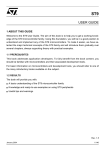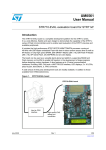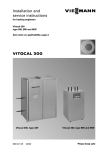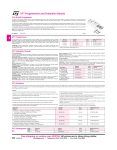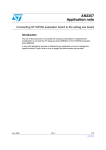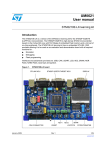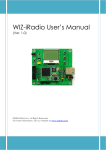Download STR730-EVAL evaluation board for STR73xF
Transcript
UM0559 User Manual STR730-EVAL evaluation board for STR73xF Introduction The STR730-EVAL board is a complete development platform for the STR73x series. It is a cost effective, flexible and open design to demonstrate the capability of the STR730 series of flash micro-controllers and to enable rapid evaluation of the STR73x devices and available peripherals. It includes the high performance STR730F ARM7TDMITM processor running at up to 36 MHz, that features a rich set of peripherals and serial communication interfaces, including CAN (controller area network), STR730F, SPI EEPROM, I2C EEPROM and an LCD display. The board can be used as a versatile stand-alone test platform, supporting a CAN interface and a UART RS232 interface, LED displays, 2 x 16 LCDs, piezo buzzer, test buttons, a JTAG connector and an analog channel. A wide choice of third party development tools are readily available in addition to the those available from STMicroelectronics. Figure 1. STR730-EVAL board STR730-EVAL board Host to JTAG interface High speed JTAG debug port connection June 2008 Rev 1 1/29 www.st.com Contents UM0559 Contents 1 2 3 Introduction . . . . . . . . . . . . . . . . . . . . . . . . . . . . . . . . . . . . . . . . . . . . . . . . 3 1.1 Processor and memory devices on this board . . . . . . . . . . . . . . . . . . . . . . 3 1.2 Board interface connections . . . . . . . . . . . . . . . . . . . . . . . . . . . . . . . . . . . . 4 1.3 Push buttons . . . . . . . . . . . . . . . . . . . . . . . . . . . . . . . . . . . . . . . . . . . . . . . 4 1.4 Displays . . . . . . . . . . . . . . . . . . . . . . . . . . . . . . . . . . . . . . . . . . . . . . . . . . . 4 Hardware . . . . . . . . . . . . . . . . . . . . . . . . . . . . . . . . . . . . . . . . . . . . . . . . . . 5 2.1 Overview . . . . . . . . . . . . . . . . . . . . . . . . . . . . . . . . . . . . . . . . . . . . . . . . . . 7 2.2 Processor . . . . . . . . . . . . . . . . . . . . . . . . . . . . . . . . . . . . . . . . . . . . . . . . . . 7 2.3 Debug . . . . . . . . . . . . . . . . . . . . . . . . . . . . . . . . . . . . . . . . . . . . . . . . . . . . . 7 2.4 Prototype area . . . . . . . . . . . . . . . . . . . . . . . . . . . . . . . . . . . . . . . . . . . . . . 7 2.5 Reset . . . . . . . . . . . . . . . . . . . . . . . . . . . . . . . . . . . . . . . . . . . . . . . . . . . . . 7 2.6 Power supplies . . . . . . . . . . . . . . . . . . . . . . . . . . . . . . . . . . . . . . . . . . . . . . 7 2.7 CAN interface . . . . . . . . . . . . . . . . . . . . . . . . . . . . . . . . . . . . . . . . . . . . . . . 7 2.8 RS232 serial interfaces . . . . . . . . . . . . . . . . . . . . . . . . . . . . . . . . . . . . . . . 8 2.9 Analog input . . . . . . . . . . . . . . . . . . . . . . . . . . . . . . . . . . . . . . . . . . . . . . . . 8 2.10 LEDs . . . . . . . . . . . . . . . . . . . . . . . . . . . . . . . . . . . . . . . . . . . . . . . . . . . . . 8 2.11 Push buttons . . . . . . . . . . . . . . . . . . . . . . . . . . . . . . . . . . . . . . . . . . . . . . . 9 2.12 Option jumper placement . . . . . . . . . . . . . . . . . . . . . . . . . . . . . . . . . . . . . 10 2.13 Option switch settings . . . . . . . . . . . . . . . . . . . . . . . . . . . . . . . . . . . . . . . 11 Connectors . . . . . . . . . . . . . . . . . . . . . . . . . . . . . . . . . . . . . . . . . . . . . . . 14 3.1 CAN bus connector . . . . . . . . . . . . . . . . . . . . . . . . . . . . . . . . . . . . . . . . . 14 3.2 RS232 serial data connector . . . . . . . . . . . . . . . . . . . . . . . . . . . . . . . . . . 14 3.3 Debug . . . . . . . . . . . . . . . . . . . . . . . . . . . . . . . . . . . . . . . . . . . . . . . . . . . . 15 3.4 Input/output summary . . . . . . . . . . . . . . . . . . . . . . . . . . . . . . . . . . . . . . . 15 4 Schematics . . . . . . . . . . . . . . . . . . . . . . . . . . . . . . . . . . . . . . . . . . . . . . . 19 5 Revision history . . . . . . . . . . . . . . . . . . . . . . . . . . . . . . . . . . . . . . . . . . . 28 2/29 UM0559 1 Introduction Introduction STMicroelectronics is a global independent semiconductor company that designs, develops, manufactures and markets a broad range of semiconductor integrated circuits and discrete devices used in a wide variety of applications. The STR730-EVAL board is based on the STR730FZ2T7, a highly integrated microcontroller, running at up to 36 MHz that uses the popular ARM7TDMITM 32-bit RISC CPU featuring on-chip high speed single voltage flash memory and high-speed RAM, clock generation via PLL, and numerous on-chip peripherals. This board is intended as low cost development platform to demonstrate the capability of the STR730 series of flash micro-controllers and to enable rapid evaluation of the STR730 devices and available peripherals. The STR730-EVAL board has 8-Kbit SPI EEPROM and 8-Kbit I2C EEPROM and supports CAN and RS232 interfaces. It includes a 2 x 16 programmable LCD display supported by select, next, back, previous and wake-up push buttons. The hardware platform of the STR730F series is supported by an extensive software support package, including device drivers in ANSI C source form and demonstration software. It is flashed with a demonstration application that shows the basic features of the device. Development tools are readily available. This is complemented by a range of third party real-time OS and middleware. Design schematics can also be supplied in electronic format to those customers with compatible design environments. Note: ARM® and ARM7TDMITM are registered trademarks of ARM Limited in the EU and other countries. 1.1 Processor and memory devices on this board ● STR730F ARM7TDMITM processor running at up to 36 MHz, IC11: – 144-pin TQFP version, – 256 Kbytes flash program memory, – 16 Kbytes RAM, – embedded 1.8 V voltage regulator for core supply, – nested interrupt controller. ● Clocking is performed by a surface mounted 8 MHz quartz. ● Serial ROMs: – 8-Kbit SPI EEPROM connected to the buffered serial peripheral interface (BSPI2): IC7, – I2C EEPROM: 8-Kbit EEPROM connected to the I2C0 interface: IC8. 3/29 Introduction 1.2 UM0559 Board interface connections Diagrams and wiring descriptions for these connectors are provided in Chapter 4: Schematics on page 19. The following connections are supported by the board: 1.3 ● CAN uses a single 9 D-type connector with microswitch selectable low or high speed transceiver: CN4 ● UART0 (Rx and Tx only) connected to a 9-way male D-type RS232 connector: CN2 ● UART1 (Rx and Tx only) connected to a 9-way male D-type RS232 connector: CN3 ● JTAG, 20 pin IDC connector: CN1 ● variable resistor, voltage range 0 to 4.5 V: R33 ● LM35 temperature sensor: IC9 ● prototype area: GD1 ● test points, various test points are located throughout the board, for details see Chapter 4: Schematics on page 19 ● main power supply: CN5 Push buttons The following push buttons are provided: 1.4 ● next (NEXT), programmable switch: SW12 ● previous (PREV), programmable switch: SW13 ● reset (RST), board reset: SW14 ● select (SEL), programmable switch: SW15 ● back (BACK), programmable switch: SW16 ● wakeup (WAKE-UP), push button to bring processor out of low power mode: SW17 Displays The following LCD and LEDs are provided: 4/29 ● LCD display, 2x16 LCD display connected to a general purpose input/output LCD interface; green back light display: LCD1 ● surface mount red, +5 V power indicator: LD19 ● bi-color red/green: LD17, LD21, LD22, LD23, LD24, LD25 ● low consumption LEDs red: LD1, LD2, LD3, LD4, LD5, LD6, LD7, LD8, LD9, LD10, LD11, LD12, LD13, LD14, LD15, LD16 UM0559 Hardware 2 Hardware Figure 2. STR730-EVAL board layout block diagram LD 2 LD 4 LD 6 LD 8 LD 10 LD 12 LD 14 LD 16 LD 1 LD 3 LD 5 LD 7 LD 9 LD 11 LD 13 LD 15 RS232-A UART 0 Rx and Tx only CN2 JTAG CN1 RS232-B UART 1 Rx and Tx only CN3 SPI EEPROM IC7 CAN CN4 Variable resistor R33 L9616 IC5 +5 V power CN5 L9669 IC2 DC power filter IC3 STR730FZ2T7 ARM7TDMITM NEXT PREV RST SEL BACK WAKE-UP LCD display Prototype area GD1 Buzzer SPKR1 8 MHz quartz XT1 LD 17 LD 22 LD 21 LD 24 LD 23 LD 25 LM35 IC9 I2C EEPROM IC8 5/29 Hardware UM0559 Figure 3. STR730-EVAL board system block diagram Prototype area LEDs GPIO4/PWM In-circuit emulator JTAG CAN0/ CAN1 GPIO RS232 Rx and Tx LCD UART0 I2C0 RS232 Rx and Tx High speed/ fault tolerant CANH and CANL I2C EEPROM UART1 BSPI2 SPI EEPROM Variable resistor Analog input Audio out Temperature sensor 5 V power 6/29 Piezo Buzzer UM0559 2.1 Hardware Overview The STR730-EVAL board is a general purpose evaluation platform with CAN (controller area network), and RS232 interfaces. 2.2 Processor The board supports the STR730FZ2T7 ARM7TDMITM silicon - 144-pin TQFP version. This chip runs at a frequency of up to 36 MHz. Boot modes and configuration options are set using microswitches. 2.3 Debug Software debug uses a standard 20-pin JTAG connection. This may connect to a standard host to JTAG interface. 2.4 Prototype area A 2.54 x 2.54 mm gridded area of 1mm holes is available for prototyping using wire wrap or similar prototyping techniques. 2.5 Reset The reset sources are: 2.6 ● power on reset, ● push button reset, ● JTAG reset from an in-circuit emulator. Power supplies Power to the board is supplied using a lump in cord power supply providing 5 V to the board. All other required voltages are provided by on-board voltage regulators. 2.7 CAN interface A general purpose, asynchronous serial I/O data port connected through a 9-pin D-type male connector with microswitch selectable low speed fault tolerant transceiver (L9669) or low or high speed selectable transceiver (L9616). See Section 3.1: CAN bus connector on page 14. The L9669 transceiver only works in normal mode, the wake-up functionality is not implemented. 7/29 Hardware 2.8 UM0559 RS232 serial interfaces Two general purpose, asynchronous serial I/O data ports are connected through 9-pin Dtype male connectors refer to Section 3.2: RS232 serial data connector on page 14. RS232-A connects directly to UART0, transmit and receive only. RS232-B connects to UART1, transmit and receive only. RTS is shorted to CTS and DTR is shorted to DSR at the connector for both interfaces. 2.9 Analog input The following analog inputs are provided, see the schematics Figure 10 on page 19: ● LM35 temperature sensor IC9 is connected to AIN1, ● variable resistor R33 is connected to AIN0. 2.10 LEDs 2.10.1 Software controlled LEDs The LEDs in Table 1 are software controlled by PIO pins. Table 1. 8/29 Software controlled LEDs LED Connected to LD1 P4_0 LD2 P4_1 LD3 P4_2 LD4 P4_3 LD5 P4_4 LD6 P4_5 LD7 P4_6 LD8 P4_7 LD9 P4_8 LD10 P4_9 LD11 P4_10 LD12 P4_11 LD13 P4_12 LD14 P4_13 LD15 P4_14 LD16 P4_15 Color Schematic Red Figure 15 on page 24 UM0559 Hardware Table 1. Software controlled LEDs (continued) LED Connected to Color LD17 PWM5_P2.7 Red/green LD21 PWM3_P2.5 LD22 PWM4_P2.6 LD23 PWM1_P2.3 LD24 PWM2_P2.4 LD25 PWM0_P2.0 Schematic Figure 10 on page 19 2.10.2 Status LED LD19 is the +5 V power indicator. This LED is red, see Figure 11 on page 20. 2.11 Push buttons The schematic diagram for the push buttons is in Figure 10 on page 19. Table 2. Push buttons Button Connected to Next SW12 INT6_P5.8 Previous SW13 INT7_P5.9 Board reset SW14 notRSTIN Select SW15 INT8_P5.10 Back SW16 INT9_P511 Wake-up SW17 WUP16_P2.10 9/29 Hardware UM0559 2.12 Option jumper placement Figure 4. Option jumpers and switches J3 J2 SW2 SW1 SW4 SW5 SW3 SW8 SW6 SW7 STR730FZ2T7 ARM7TDMITM Prototype area NXT PREV RST SEL BACK WAKE-UP SW12 SW15 SW13 SW16 SW14 SW17 J5 J7 10/29 SW10 SW11 SW9 J6 UM0559 Hardware Table 3. Option jumpers Jumper Schematic Description Default J2 Figure 17 on page 26 CAN link: not fitted / fitted (default) Fitted J3 Figure 11 on page 20 CPUIO: +5 V Fitted J5 Figure 10 on page 19 XTAL2 Fitted J6 Figure 10 on page 19 TST pull-down FItted J7 Figure 10 on page 19 XTAL1 Fitted Jumpers are fitted as shown in Figure 5: Figure 5. Jumper positions 1-2 Not fitted 2.13 Do not fit 2-3 Fitted Option switch settings Table 4. Option switch settings Switch Schematic SW1 Figure 17 on page 26 SW2 Description CAN transceiver select: L9669 / L9616 (default) Note SW1 and SW2 must be changed together. 1 = L9669 A = L9616 Default A A Figure 17 on page 26 L9616 ASC speed: 1-2 = pull down = high speed 2-3 = pull up = low speed 2-3 SW4 Figure 13 on page 22 SPI EEPROM notW: 1-2 = pull down = Write protect 2-3 = pull up = Write enabled 2-3 SW5 Figure 13 on page 22 SPI EEPROM notHOLD: 1-2 = pull down = SPI EEPROM in “hold mode” 2-3 = pull up = SPI EEPROM in “normal mode” 2-3 Figure 10 on page 19 CAN device select: channel 0 / channel 1 Note SW6 and SW8 must be changed together. 1-2 = channel 0 2-3 = channel 1 1-2 Figure 18 on page 27 I2C EEPROM write control (notWC): 1-2 = pull down = enable writes to EEPROM 2-3 = pull up = disable writes to EEPROM 1-2 SW3 SW6 SW7 11/29 Hardware UM0559 Table 4. Option switch settings (continued) Switch Schematic Description Default Figure 10 on page 19 CAN device select: channel 0 / channel 1 Note SW6 and SW8 must be changed together. 1-2 = channel 0 2-3 = channel 1 1-2 SW9 Figure 10 on page 19 Bit Boot M0, boot from internal flash, see Table 5. 1-2 = M0 low 2-3 = M0 high 1-2 SW10 Figure 10 on page 19 SPEAKER Channel OCPMA0 / OCPMA1 (default) 1-2 SW11 Figure 10 on page 19 Bit Boot M1, boot from internal flash, see Table 5. 1-2 = M1 low 2-3 = M1 high 1-2 SW12 Figure 10 on page 19 Next Push to make SW13 Figure 10 on page 19 Previous Push to make SW14 Figure 10 on page 19 Reset Push to make SW15 Figure 10 on page 19 Select Push to make SW 16 Figure 10 on page 19 Back Push to make SW 17 Figure 10 on page 19 Wake up Push to make SW8 For switch position details, see Figure 6. Figure 6. Switch positions 1-2 2-3 Microswitches 12/29 1 A 1 1 A A Slide switches UM0559 Table 5. Hardware Boot modes BootM1 BootM0 SW11 SW9 1-2 1-2 Mode User1 Memory mapping Note Flash sector B0F0 All flash sectors visible except mapped at 0h system memory sector STR730 BOOT M1 BOOT M0 1-2 2-3 User2 Flash sector B0F0 Flash B0F1 sector and system mapped at 0h memory sector not visible STR730 BOOT M1 BOOT M0 2-3 1-2 Boot System memory mapped at 0h SW10 SW11 SW9 SW10 SW11 SW9 STR730 BOOT M1 BOOT M0 SW10 SW11 SW9 STR730 2-3 2-3 Reserved - . BOOT M1 BOOT M0 SW10 SW11 SW9 13/29 Connectors UM0559 3 Connectors 3.1 CAN bus connector Figure 7. CAN connector 9 pin male D-type: CN4 CAN - data 2 3 4 1 6 Table 6. 3.2 7 8 5 9 CAN connector pinout: CN4 Pin Description Pin Description 1 Not connected 4 Not connected 7 CAN H, high side bus output 2 CAN L, low side bus output 5 Not connected 8 Pull down to ground 3 Ground Ground Pull up to +5 V 6 Pin Description 9 RS232 serial data connector 9-pin general purpose D-type male connectors. Figure 8. RS232 transmit and receive connectors: CN2, CN3 RS232 - Data A 1 2 6 Table 7. 14/29 3 7 4 8 1 5 9 RS232 - Data B 2 3 4 5 6 7 8 9 RS232 connector pinout: CN2, CN3 Pin Description Pin Description Pin Description 1 Shorted to pin 4 and 6 4 Shorted to pin 1 and 6 7 Shorted to pin 8 2 R1IN (port A), R2IN (port B) 5 Ground 8 Shorted to pin 7 3 T1OUT (port A), T2OUT (port B) 6 Shorted to pin 1 and 4 9 Not connected UM0559 3.3 Connectors Debug Figure 9. JTAG standard interface: CN1 Debug-JTAG port 19 17 20 Table 8. 15 18 16 13 14 11 12 9 7 5 3 1 10 8 6 4 2 JTAG interface pinout: CN1 Pin Description Pin Description Pin Description 4, 6, 8, 10, 12, 14, 16, 18, 20 Ground 5 TDI 13 TD0 1 VTref +5 V 7 TMS 15 notReset 2 Vsupply +5 V 9 TCK 17 DBGRQS - pulled low 3 notTRST 11 RTCK (GROUND) 19 DBGACK - pulled low Note: In order for hardware and JTAG RESET to be synchronized, (R3, R6, R5,C2,TR2, TR1) have to be fitted, see Figure 16: ARM JTAG interface on page 25. 3.4 Input/output summary Table 9. STR730-EVAL board input/output summary Port Peripheral Alternate function P0.0 LCD_D0 OCMPB2 P0.1 LCD_D1 OCMPA2 P0.2 LCD_D2 ICAPA2 P0.3 LCD_D3 ICAPB2 P0.4 LCD_D4 OCMPA5 P0.5 LCD_D5 OCMPB5 P0.6 LCD_D6 ICAPA5 P0.7 LCD_D7 ICAPB5 P0.8 LCD_RS OCMPA6 P0.9 LCD_nE OCMPB6 P0.10 LCD_RW OCMPA7 P0.11 TP52 OCMPB7 P0.12 TP53 ICAPA3 Interrupt 15/29 Connectors UM0559 Table 9. 16/29 STR730-EVAL board input/output summary (continued) Port Peripheral Alternate function Interrupt P0.13 TP54 ICAPB3 P0.14 TP55 OCMPB3 P0.15 TP56 OCMPA3 P1.0 TP57 OCMPA4 P1.1 Test Point OCMPB4 P1.2 Test Point ICAPB4 P1.3 Test Point ICAPA4 P1.4 Test Point P1.5 Test Point P1.6 Test Point OCMPB1 P1.7 PIEZO (SW10-1) OCMPA1 P1.8 PIEZO (SW10-3) OCMPA0 INT0 P1.9 Test Point OCMPB0 INT1 P1.10 Test Point WUP28 P1.11 Test Point WUP29 P1.12 Test Point WUP30 P1.13 Test Point WUP31 P1.14 CAN_RX (SW6-1) CAN0RX P1.15 CAN_TX (SW8-1) CAN0TX P2.0 BiColor LED - LD25 PWM0 P2.1 CAN_RX (SW6-3) CAN1RX P2.2 CAN_TX (SW8-3) CAN1TX P2.3 BiColor LED - LD23 PWM1 P2.4 BiColor LED - LD24 PWM2 P2.5 BiColor LED - LD21 PWM3 P2.6 BiColor LED - LD22 PWM4 P2.7 BiColor LED - LD17 PWM5 P2.8 UART_TXB UART1_TX P2.9 UART_RXB UART1_RX P2.10 SW_WAKEUP WUP16 P2.11 Test Point WUP17 P2.12 I2C_E1 / TP INT14 P2.13 I2C_E2 / TP INT15 P2.14 I2C_SCL SCL0 P2.15 I2C_SDA SDA0 WUP12 WUP13 WUP14 UM0559 Connectors Table 9. STR730-EVAL board input/output summary (continued) Port Peripheral Alternate function Interrupt P3.0 10K_POT AIN0 P3.1 LM35_THERM AIN1 P3.2 Test Point AIN2 P3.3 Test Point AIN3 P3.4 Test Point AIN4 P3.5 Test Point AIN5 P3.6 Test Point AIN6 P3.7 Test Point AIN7 P3.8 Test Point AIN8 P3.9 Test Point AIN9 P3.10 Test Point AIN10 P3.11 Test Point AIN11 P3.12 Test Point AIN12 INT2 P3.13 Test Point AIN13 INT3 P3.14 Test Point AIN14 INT4 P3.15 Test Point AIN15 INT5 P4.0 LED_LD1 ICAPA7 P4.1 LED_LD2 ICAPB7 P4.2 LED_LD3 ICAPA8 P4.3 LED_LD4 ICAPB8 P4.4 LED_LD5 P4.5 LED_LD6 P4.6 LED_LD7 SCL1 P4.7 LED_LD8 SDA1 P4.8 LED_LD9 OCMPA8 P4.9 LED_LD10 ICAPB6 P4.10 LED_LD11 ICAPA6 P4.11 LED_LD12 OCMPB8 P4.12 LED_LD13 ICAPA9 P4.13 LED_LD14 ICAPB9 P4.14 LED_LD15 nSS1 P4.15 LED_LD16 SCLK1 P5.0 TP7 MOSI1 P5.1 TP6 MISO1 P5.2 TP5 OCMPA9 WUP18 WUP19 WUP20 WUP21 WUP22 17/29 Connectors UM0559 Table 9. 18/29 STR730-EVAL board input/output summary (continued) Port Peripheral Alternate function Interrupt P5.3 M95_EE_CS OCMPB9 P5.4 CPU_IO nSS2 P5.5 M95_EE_CLK SCLK2 P5.6 M95_EE_MOSI MOSI2 P5.7 M95_EE_MISO MISO2 P5.8 SW_NEXT INT6 P5.9 SW_PREV INT7 P5.10 SW_SEL INT8 P5.11 SW_BACK INT9 P5.12 TP4 INT10 P5.13 TP3 INT11 P5.14 TP10 INT12 P5.15 TP14 INT13 P6.0 TP13 WUP0 P6.1 TP12 WUP1 P6.2 TP11 WUP2 P6.3 TP20 WUP3 P6.4 TP17 WUP4 P6.5 TP18 WUP5 P6.6 TP22 WUP6 P6.7 TP21 WUP7 P6.8 UART_RXA UART0_RX P6.9 UART_TXA UART0_TX P6.10 TP19 P6.11 TP36 MISO0 P6.12 TP34 MOSI0 P6.13 TP38 SCLK0 P6.14 TP37 nSS0 P6.15 TP35 WUP23 WUP10 WUP11 WUP9 UM0559 4 Schematics Schematics Figure 10. STR730-EVAL board top sheet 1 of 2 19/29 Schematics Figure 11. STR730-EVAL board top sheet 2 of 2 20/29 UM0559 UM0559 Schematics Figure 12. RS232 interface 21/29 Schematics Figure 13. SPI EEPROM interface 22/29 UM0559 UM0559 Schematics Figure 14. GPIO LCD 23/29 Schematics Figure 15. LED interface 24/29 UM0559 UM0559 Schematics Figure 16. ARM JTAG interface 25/29 Schematics Figure 17. CAN interface 26/29 UM0559 UM0559 Schematics Figure 18. I2C EEPROM interface 27/29 Revision history 5 UM0559 Revision history Table 10. Document revision history Date 26-Jun-2008 28/29 Revision 1 Changes Initial release. UM0559 Please Read Carefully: Information in this document is provided solely in connection with ST products. STMicroelectronics NV and its subsidiaries (“ST”) reserve the right to make changes, corrections, modifications or improvements, to this document, and the products and services described herein at any time, without notice. All ST products are sold pursuant to ST’s terms and conditions of sale. Purchasers are solely responsible for the choice, selection and use of the ST products and services described herein, and ST assumes no liability whatsoever relating to the choice, selection or use of the ST products and services described herein. No license, express or implied, by estoppel or otherwise, to any intellectual property rights is granted under this document. If any part of this document refers to any third party products or services it shall not be deemed a license grant by ST for the use of such third party products or services, or any intellectual property contained therein or considered as a warranty covering the use in any manner whatsoever of such third party products or services or any intellectual property contained therein. UNLESS OTHERWISE SET FORTH IN ST’S TERMS AND CONDITIONS OF SALE ST DISCLAIMS ANY EXPRESS OR IMPLIED WARRANTY WITH RESPECT TO THE USE AND/OR SALE OF ST PRODUCTS INCLUDING WITHOUT LIMITATION IMPLIED WARRANTIES OF MERCHANTABILITY, FITNESS FOR A PARTICULAR PURPOSE (AND THEIR EQUIVALENTS UNDER THE LAWS OF ANY JURISDICTION), OR INFRINGEMENT OF ANY PATENT, COPYRIGHT OR OTHER INTELLECTUAL PROPERTY RIGHT. UNLESS EXPRESSLY APPROVED IN WRITING BY AN AUTHORIZED ST REPRESENTATIVE, ST PRODUCTS ARE NOT RECOMMENDED, AUTHORIZED OR WARRANTED FOR USE IN MILITARY, AIR CRAFT, SPACE, LIFE SAVING, OR LIFE SUSTAINING APPLICATIONS, NOR IN PRODUCTS OR SYSTEMS WHERE FAILURE OR MALFUNCTION MAY RESULT IN PERSONAL INJURY, DEATH, OR SEVERE PROPERTY OR ENVIRONMENTAL DAMAGE. ST PRODUCTS WHICH ARE NOT SPECIFIED AS "AUTOMOTIVE GRADE" MAY ONLY BE USED IN AUTOMOTIVE APPLICATIONS AT USER’S OWN RISK. Resale of ST products with provisions different from the statements and/or technical features set forth in this document shall immediately void any warranty granted by ST for the ST product or service described herein and shall not create or extend in any manner whatsoever, any liability of ST. ST and the ST logo are trademarks or registered trademarks of ST in various countries. Information in this document supersedes and replaces all information previously supplied. The ST logo is a registered trademark of STMicroelectronics. All other names are the property of their respective owners. © 2008 STMicroelectronics - All rights reserved STMicroelectronics group of companies Australia - Belgium - Brazil - Canada - China - Czech Republic - Finland - France - Germany - Hong Kong - India - Israel - Italy - Japan Malaysia - Malta - Morocco - Singapore - Spain - Sweden - Switzerland - United Kingdom - United States of America www.st.com 29/29





























